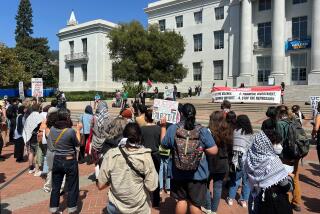Israel Agrees to Bypass Campus
JERUSALEM — Bowing to international opposition, Israel has agreed to route its controversial security barrier around a prominent Palestinian university rather than directly through the campus as originally proposed, school officials said Monday.
But the government of Prime Minister Ariel Sharon also signaled its intention to include a sprawling Jewish settlement in the West Bank on its side of the fence, a move likely to incur Washington’s wrath and possible cuts in U.S. loan guarantees to Israel.
The decision not to slice Al Quds University in two came after weeks of pressure from the Bush administration, other foreign powers and an almost nonstop peaceful protest on the southeastern Jerusalem campus by students, professors and administrators.
The original route of the security partition would have taken away more than a quarter of the university’s property, including a basketball court and soccer field that constitute the only sports facilities available to Al Quds’ 6,000 students.
The Israeli government contends that the fence is necessary to keep would-be terrorists from entering Jerusalem, but students and teachers successfully rallied international support against what they called an attack on civilization and learning.
“The Israelis know that harming the academy could damage their image,” said Amjad Abu Asab, 23, a law student who was a leader of the protest. “After we escalated our actions, Israel could not go on with its project to confiscate the land.”
The security barrier will now meander along the edge of the campus, possibly cutting into some of the university’s property but a substantially smaller amount than the 15 acres previously threatened, said Dimitri Diliani, an aide to university President Sari Nusseibeh.
The Israeli Defense Ministry made the concession Monday at a meeting with university officials. Afterward, the ministry declined to comment on the new route, saying in a statement only that “an understanding was reached that will provide for the construction of the security fence in the area of Al Quds University.”
Since the original plan came to light last month, activists have kept a near-continuous presence on the basketball court and soccer field, blocking the bulldozers ready to rumble in and holding lectures, administrative meetings, athletic events, a regional chess tournament, Friday prayers and weekend concerts. A stream of diplomats came calling, most recently a delegation from the European Union on Sunday.
Diliani said that the key to earning widespread support was the demonstrators’ determination to keep their protests peaceful.
“I don’t think the world would be sympathetic to us if our resistance was otherwise,” he said. “It has been an educational experience for our students to show what kind of resistance pays, and at the same time it sets an example for the Palestinian people.”
The fence that will edge around Al Quds is part of a larger security partition -- consisting variously of barbed wire, concrete walls and deep trenches -- that Israel is erecting throughout the West Bank, in some cases cutting deeply into the Palestinian territories.
A major dispute over the barrier -- one that has put the Israeli government at odds with the U.S. -- centers on whether to place the large Jewish settlement of Ariel, southwest of the West Bank city of Nablus, inside or outside the fence.
The Bush administration has warned Sharon’s government against including Ariel on the Israeli side for fear that it would become a de facto border and harm the chances of establishing a contiguous Palestinian state, as envisioned by the Mideast peace initiative known as the “road map.”
Washington has threatened to deduct loan guarantees equal to the amount Israel would spend on building the barrier around Ariel.
Although the warnings appeared to give Sharon pause, he indicated in a meeting Monday with members of his party that some, if not all, of the settlement would fall on the Israeli side of the fence. The exact route is to be decided by the Cabinet this week.
Trying to balance the White House’s anger with domestic political concerns, Vice Premier Ehud Olmert told Israeli radio: “I only want to tell all those sneering at us, who say we are following the U.S.’ dictates, that no, we are doing the right thing. But we don’t have to be the U.S.’ servant in order to listen to what it is telling us in order to see whether we can reach an understanding.”
In Washington, the administration was preparing to inform Congress today how much it planned to give Israel in loan guarantees. Because the United States has long disagreed with Israel’s policy of settling the West Bank and Gaza Strip, the two nations long ago agreed to subtract the amount Israel spends on the settlements from the U.S.-guaranteed loans Israel receives each year.
This year, administration officials have dropped anonymous hints that they may also reduce the loan guarantees to express their displeasure over the fence.
State Department spokesman Richard Boucher was tight-lipped Monday about how much the loan guarantee might be reduced, whether the fence would figure into the U.S. calculus and even if the administration would meet the deadline for reporting its intentions to Congress.
“I would expect we’ll have an appropriate answer at an appropriate time,” Boucher said. “I just can’t promise exactly when.”
*
Times staff writer Sonni Efron in Washington contributed to this report.
More to Read
Sign up for Essential California
The most important California stories and recommendations in your inbox every morning.
You may occasionally receive promotional content from the Los Angeles Times.










